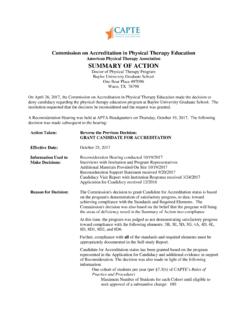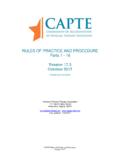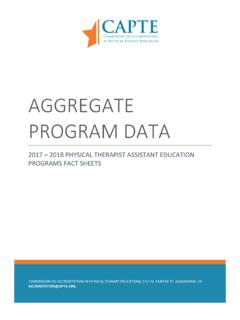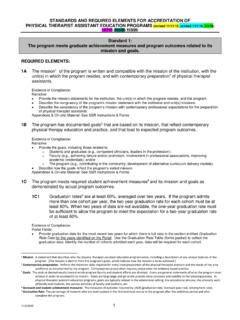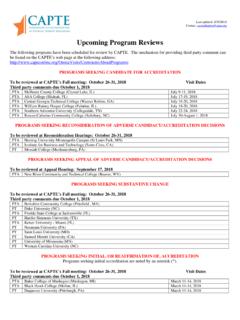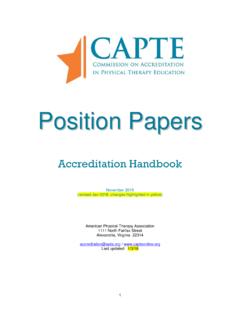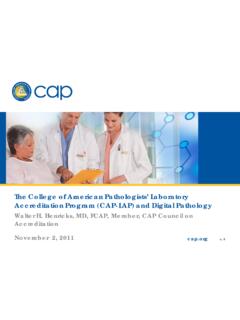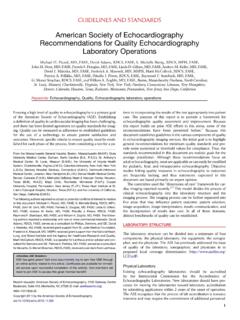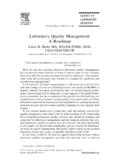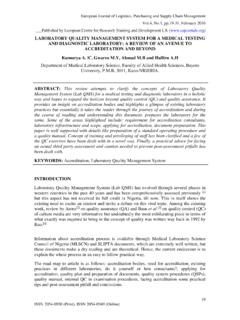Transcription of EEvvaalluuaattiivvee CCrriitteerriiaa PPTT …
1 PT Evaluative Criteria Revised August 2014 EEvvaalluuaattiivvee CCrriitteerriiaa pptt PPrrooggrraammss August 2014 Note: Highlighted sections represent most recent revisions IMPORTANT: This document is NOT appropriate for use in developing an Application for Candidacy (AFC). A Word version of the AFC is provided to the program director of a developing program upon hire. American Physical Therapy Association 1111 North Fairfax Street Alexandria, Virginia 22314 / Last updated: 8/7/2014 PT Evaluative Criteria Revised January 2014 i EVALUATIVE CRITERIA FOR ACCREDITATION OF EDUCATION PROGRAMS FOR THE PREPARATION OF PHYSICAL THERAPISTS (Adopted October 26, 2004 and effective January 1, 2006; revised 5/07, 10/07, 4/09, 10/09, 4/10, 5/11, 11/11, 11/12, 11/13; 8/14) INTRODUCTION The Commission on Accreditation in Physical Therapy Education (CAPTE or the Commission) is the only agency in the United States recognized to accredit education programs for the preparation of physical therapists.
2 CAPTE also accredits a limited number of physical therapist education programs in other countries at the request of the program and the sponsoring institution. CAPTE attempts to ensure that accredited programs prepare graduates who will be effective contemporary practitioners of physical therapy. The Commission acknowledges the critical role of the profession in defining the nature of contemporary practice and determining practice expectations and the demands that are placed on graduates. The profession has defined these expectations in two documents that were developed through lengthy, participatory processes. The Guide to Physical Therapist Practice1 (the Guide) is a core document of the profession that describes the practice of physical therapy. The Guide was first published in 1995, was revised in 1999 and again in 2003, and is the culmination of work that began in 1992.
3 Part One: A Description of Patient/Client Management is particularly relevant to these evaluative criteria. A Normative Model of Physical Therapist Professional Education: Version 20042 (Normative Model) is the latest revision of a document originally developed in 1994-95 though a consensus process involving a significant portion of the physical therapy education community. The Normative Model describes the profession s preferred prerogatives, perspectives, beliefs and values relative to physical therapist education [and is intended to] serve as a primary resource for the Commission on Accreditation in Physical Therapy Education (CAPTE) in its periodic review and assessment of the evaluative criteria for physical therapist educational programs. 2(p5) Other core documents that guide the profession and influence these criteria include the APTA Code of Ethics,3 the Guide for Professional Conduct,4 and the Standards of A.
4 THE PROFESSION AND THE PRACTICE ENVIRONMENT Physical therapy, as a profession, dates from the beginning of the 20th century, when the advances in health care made possible the survival of people affected by poliomyelitis and war injuries. Physical therapy has continued to evolve and to respond to the needs of society, with physical therapists now practicing in a variety of clinical settings with unprecedented levels of professional responsibility. Physical therapists are integral members of the primary care team and are involved in prevention of disability and promotion of positive health, as well as acting as consultants in restorative care. Physical therapist practice today is based on a well-developed body of scientific and clinical knowledge. Physical therapists also apply knowledge from the basic, behavioral, and social sciences.
5 1 Guide to Physical Therapist Practice. 2nd ed. Alexandria, VA: American Physical Therapy Association; 2001. Rev. June 2003. 2 A Normative Model of Physical Therapist Professional Education: Version 2004. Alexandria, VA: American Physical Therapy Association; 2004. 3 Code of Ethics. American Physical Therapy Association. 4 APTA Guide for Professional Conduct. American Physical Therapy Association. 5 Standards of Practice for Physical Therapy. American Physical Therapy Association. PT Evaluative Criteria Revised January 2014 ii According to the Guide to Physical Therapist Practice:(pp31-32) Physical therapy is defined as the care and services provided by, or under the direction and supervision of, a physical therapist.
6 Physical therapists are the only professionals who provide physical therapy interventions. Physical therapist assistants are the only individuals who provide selected physical therapy interventions under the direction and supervision of the physical therapist. Physical therapists: Provide services to patients/clients who have impairments, functional limitations, disabilities, or changes in physical function and health status resulting from injury, disease, or other causes. In the context of the model of disablement, on which this Guide is based, impairment is defined as loss or abnormality of anatomical, physiological, mental, or psychological structure or function; functional limitation is defined as restriction of the ability to perform, at the level of the whole person, a physical action, task, or activity in an efficient, typically expected, or competent manner; and disability is defined as the inability to perform or a limitation in the performance of actions, tasks, and activities usually expected in specific social roles that are customary for the individual or expected for the person s status or role in a specific sociocultural context and physical environment.
7 Interact and practice in collaboration with a variety of professionals. The collaboration may be with physicians, dentists, nurses, educators, social workers, occupational therapists, speech-language pathologists, audiologists, and any other personnel involved with the patient/client. Physical therapists acknowledge the need to educate and inform other professionals, government agencies, third-party payers, and other health care consumers about the cost-efficient and clinically effective services that physical therapists provide. Address risk. Physical therapists identify risk factors and behaviors that may impede optimal functioning. Provide prevention [services] and promote health, wellness, and fitness. Physical therapists provide prevention services that forestall or prevent functional decline and the need for more intense care.
8 Through timely and appropriate screening, examination, evaluation, diagnosis, prognosis, and intervention, physical therapists frequently reduce or eliminate the need for costlier forms of care and also may shorten or even eliminate institutional stays. Physical therapists also are involved in promoting health, wellness, and fitness initiatives, including education and service provision that stimulate the public to engage in healthy behaviors. Consult, educate, engage in critical inquiry, and administrate. Physical therapists provide consultative services to health facilities, colleagues, businesses, and community organizations and agencies. They provide education to patients/clients, students, facility staff, communities, and organizations and agencies. Physical therapists also engage in research activities, particularly those related to substantiating the outcomes of service provision.
9 They provide administrative services in many different types of practice, research, and education settings. Direct and supervise the physical therapy service, including support personnel. Physical therapists oversee all aspects of the physical therapy service. They supervise the physical therapist assistant (PTA) when PTAs provide physical therapy interventions as selected by the physical therapist. Physical therapists also supervise any support personnel as they perform designated tasks related to the operation of the physical therapy service. Physical therapists provide health care to their patients/clients in a wide variety of settings, including, but not limited to, physical therapy office practices, hospitals, rehabilitation facilities, homes, long term care settings, schools, industrial settings, and athletic/fitness centers.
10 PT Evaluative Criteria Revised January 2014 iii Provision of care is a collaborative process that requires recognition of the essential roles of the individual, families, insurers/payers, other consumers of physical therapy services, and other health care practitioners. Caregivers must understand the continuing evolution of the health care system. Practitioners must be aware of the need to ensure high-quality care in the most efficient manner to realize societal goals for health care services and delivery. Professional education programs and the accreditation process must be responsive to the health care needs of citizens and communities as well as to the needs of the health care system. Practitioners must be prepared to participate in today s health care environment by providing direct services to individuals and groups and by contributing to improved health care delivery.
